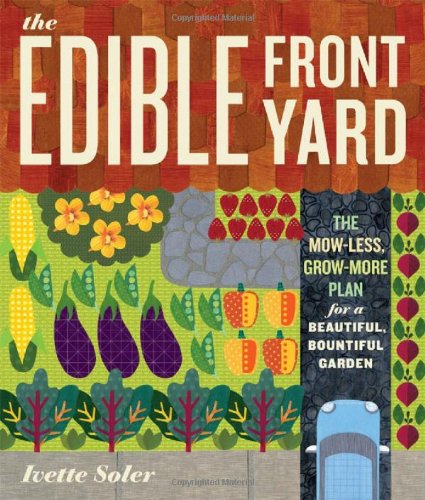People everywhere are turning patches of soil into bountiful vegetable gardens, and each spring a new crop of beginners pick up trowels and plant seeds for the first time. They’re planting tomatoes in raised beds, runner beans in small plots, and strawberries in containers. But there is one place that has, until now, been woefully neglected — the front yard.
And there’s good reason. The typical veggie garden, with its raised beds and plots, is not the most attractive type of garden, and favorite edible plants like tomatoes and cucumbers have a tendency to look a scraggily, even in their prime. But The Edible Front Yard isn’t about the typical veggie garden, and author Ivette Soler is passionate about putting edibles up front and creating edible gardens with curb appeal.
Soler offers step-by-step instructions for converting all or part of a lawn into an edible paradise; specific guidelines for selecting and planting the most attractive edible plants; and design advice and plans for the best placement and for combining edibles with ornamentals in pleasing ways. Inspiring and accessible, The Edible Front Yard is a one-stop resource for a front-and-center edible garden that is both beautiful and bountiful all year-round.






Helpful and entertaining…is this really a gardening book? Gardening books of this kind are often (a) less than entertaining to read; (b) impractical; or (c) in favor of making your yard look like a junkyard. I took this one along on an extremely boring business trip and the attendant flight delays and enjoyed it thoroughly. It covers both ornamental edibles and complimentary pure ornamentals; talks about practical issues like where to find hardscape materials at a bargain and why choosing regionally suitable plants is important; and the illustrations (even when built by one of the 3 garden owners featured) don’t generally look like a pile of rubbish with plants growing over them, as these DIY-focused books so often do. I was a little disappointed that the author spent a lot of photo space on 3 favored gardens since all 3 gardeners live in the southwest/California area; I would have preferred something more relatable to my area. The principles were good though and I am definitely hanging onto this for reference. The chapter that covered ornamental edibles was great, and included plants suitable to all parts of the country. For future issues or an author’s blog (if she has one), it would be great to cross-reference plants by the various categories she provides, such as season, type of edible, soil- and sun requirements and so on, but that’s a want, not a need. This is a helpful, informative, easy-to-follow and entertaining book.
disappointing I was disappointed in the content of this book, as was hoping for more practical design ideas/suggestions. Book was more about discussion of why removal of non edible landscape is desireable. I know that or wouldn’t be interested in ripping it all out & replacing all with edible landscaping! LOL! Was just hoping for more concrete ideas on the design of an edible garden. In all fairness however, I was a professional landscaper so this book may be of use to the novice who is not familiar with plants & trees, etc…
Great for dreaming, photos gardeners will love Because the book’s subtitle refers to a “Plan” for a garden, I expected something a wee bit more practical. But that’s just me . . . . I’m an engineer, not an artist. But what gardener wouldn’t love to gaze at the gorgeous photographs in this book and imagine “what if”?I enjoyed using the book’s photographs to dream about what my edible front yard might look like if I had buckets of money, plus more tillable land than my modest urban property provides. In my neighborhood, an edible front yard might consist of Swiss chard and an eggplant growing in place of the grass normally found in a 2-foot wide boulevard between the sidewalk and the street.The landscaping photos are beautiful, showing me what I could have if only I lived on a larger lot (suburbs, maybe?) and had the wealth to hire a landscape architect and a good contractor. But heck, there’s no harm in dreaming, is there? This book makes the dreaming even more beautiful.
Comments are disabled for this post.